On The Cross Product
On the cross product
Understand the concept and not the definition.

If you have studied vectors, then the notion of a cross product is something that you might be familiar with.
Although it is taught in many colleges and schools in its mathematical glory, this post aims to supplement the same but with an real-life example.
The cross product

The magnitude of the cross product is the area of the parallelogram with two sides A and B.
The orientation of the cross product is orthogonal to the plane containing this parallelogram.
Why on earth is it orthogonal ? Like seriously…
I mean this is one of the burning questions regarding the cross product and yet for some reason, textbooks don’t get to the bottom of this.
It is modeling a real life scenario!!
The scenario being :
When you try to twist a screw inside a block in the clockwise direction like so, the nail moves down and vice versa.

i.e When you move from the screw from u to v, then the direction of the cross product denotes the direction the screw will move.

That’s why the direction of the cross product is orthogonal. It’s really that simple :D

Have a good day!
A2A : Anonymous
More Posts from T-sci-eng and Others

The Amateur Cloud Watching Handbook (#1)
Cloud watching is one of the most pleasurable activities on the planet. You don’t need any fancy equipments or spend money to experience it. Just find a spot to rest and witness the show that nature has to offer.
It is the most breathtaking experiences one can ever resonate with.
Fellow cloud watchers from the past have identified 3 primarily forms of clouds that seems to be consistent everywhere and have named it based on its structure, for the sake of convenience.
Cirrus

Cirrus in Latin means Tendril or hair. The clouds that are like long slithers in the sky, are called by this name.

Cumulus

Cumulus in Latin means Heap or pile. They just look heaps of white floaty objects in the sky.

Stratus

Status in Latin means Layer or sheet. They occur when startas of clouds stack on top of each other.

Clouds are constantly merging and doing all sorts of crazy stuff and they rarely maintain the same shape as you might have already observed
To account for this, dude named Howard brilliantly came up with a elegant nomenclature.
If a Cirrus type cloud after some time transforms into a Stratus type, it is known as Cirrostratus.
If a Cirrus type cloud after some time transforms into a Cumulus type, it is known as Cirrocumulus
If a Stratus type cloud after some time transforms into a Cumulus type, it is known as Stratocumulus
And so on, you get the idea right. By merely observing the transformation pattern of the clouds, you can tell its name.
This helps in setting up something of a standard to express in words what you behold, although it will never exactly be the same that someone else has in mind.
Note on Language

Language is our means of expression. Sometimes we stick with the conventions that had been established by pioneers. Now, that doesn’t need to be the easiest way.
For instance QWERTY keyboard is not the best keyboard to type in, but we still follow it as a convention.

Fortunately, cloud watching conventions are so much intuitive than many others out there!
Have a good day.
PC: Ted-ed PiccoloNamek, Nissim Angdembay
( Part -2 coming out soon )
Centrifugal force and seat belts

The basic concept of a seatbelt is to protect you in an automobile collision by holding you in your seat. This prevents you from flying forward and colliding with the dashboard or windshield.
How do you do that ?
Many common seat belts design have something known as a centrifugal clutch. This arrangement has a weight attached to the end of a spool
When the spool rotates at a low speed, the weight is held through spring action and is allowed to spin freely.

But you must have noticed that if you try to pull the seat belt faster then it kinda gets stuck.
This is because as you rotate the spool faster, centrifugal force causes the weight to be pushed out and that stops the spool from rotating further.

This adds tension to your seat belt and holds you to your seat at the time of a crash.
Have a great day!
* Other seatbelt mechanisms
** Seatbelt physics
More Than You Ever Wanted to Know About Mechanical Engineering, Part 33: Stress Concentrations With Fluctuating Stresses
There’s one last complication to consider with fluctuating stresses. When we looked at the case of fully reversed stresses (that is, σ_m = 0, σ_a ≠ 0) we found a fatigue stress concentration factor based on the stress concentration factor for a static situation.
With a fluctuating stress, the situation is a little different. Since the mean stress is non-zero, the part is always under some kind of load. We can consider the effects of this constant mean stress separately from the effects of the momentary alternating stress and assign them a separate fatigue stress concentration factor, which we’ll call K_fm.
Let’s think about what’s actually physically happening to a part being subjected to a fluctuating stress. Let’s say we’re dealing with a plate with a slot in it subjected to fluctuating tension.

There’s obviously a large stress concentration at the slot that we’ll have to take into account.
There’s three different scenarios which can occur here. The first is that the maximum stress the plate sees (the largest value of combined mean and alternating stress, taking stress concentrations into account) never approaches the yield strength of the material. The plate just stretches and contracts elastically. This isn’t really any different from our previous situation with fatigue stress concentration factors - we can use the K_f factor we got earlier here.

But suppose the yield strength is exceeded. What happens then? If the maximum stress is greater than the yield strength, then the plate must deform plastically at that point of maximum stress - the slot must widen. If the slot is wider, then the stress concentration is relieved - there’s more room for movement before the geometry stops you. If other words, the fatigue stress concentration factor is lessened.
If it’s just your maximum stress that exceeds the yield strength but your minimum stress is still below it, this localized yielding will be one-sided - you’ll get a slot that’s widened on one side, but you’ll still have some overall mean stress. If this is the case, you base your stress concentration factor on the relationship of the mean and alternating stresses to the yield strength.

If both your minimum and maximum stresses exceed the yield strength of the material, you get a situation where you’ve widened the slot as far as you can without actually breaking the part on both sides and you’re experiencing a stress of magnitude equal to the yield strength at either extreme of the fluctuation. Since you now have a fluctuation with equal and opposite extremes, your mean stress is zero - the mean fatigue stress concentration factor is zero. The scenario is now one of fully reversed loading and the mean stress drops right out of it.

Solar System: Things to Know This Week
Reaching out into space yields benefits on Earth. Many of these have practical applications — but there’s something more than that. Call it inspiration, perhaps, what photographer Ansel Adams referred to as nature’s “endless prospect of magic and wonder.“
Our ongoing exploration of the solar system has yielded more than a few magical images. Why not keep some of them close by to inspire your own explorations? This week, we offer 10 planetary photos suitable for wallpapers on your desktop or phone. Find many more in our galleries. These images were the result of audacious expeditions into deep space; as author Edward Abbey said, "May your trails be crooked, winding, lonesome, dangerous, leading to the most amazing view.”

1. Martian Selfie
This self-portrait of NASA’s Curiosity Mars rover shows the robotic geologist in the “Murray Buttes” area on lower Mount Sharp. Key features on the skyline of this panorama are the dark mesa called “M12” to the left of the rover’s mast and pale, upper Mount Sharp to the right of the mast. The top of M12 stands about 23 feet (7 meters) above the base of the sloping piles of rocks just behind Curiosity. The scene combines approximately 60 images taken by the Mars Hand Lens Imager, or MAHLI, camera at the end of the rover’s robotic arm. Most of the component images were taken on September 17, 2016.
800 x 600
1024 x 768
1280 x 1024
1600 x 1200
1280 x 800
1440 x 900
1920 x 1200

2. The Colors of Pluto
NASA’s New Horizons spacecraft captured this high-resolution, enhanced color view of Pluto on July 14, 2015. The image combines blue, red and infrared images taken by the Ralph/Multispectral Visual Imaging Camera (MVIC). Pluto’s surface sports a remarkable range of subtle colors, enhanced in this view to a rainbow of pale blues, yellows, oranges, and deep reds. Many landforms have their own distinct colors, telling a complex geological and climatological story that scientists have only just begun to decode.
800 x 600
1024 x 768
1280 x 1024
1600 x 1200
1280 x 800
1440 x 900
1920 x 1200

3. The Day the Earth Smiled
On July 19, 2013, in an event celebrated the world over, our Cassini spacecraft slipped into Saturn’s shadow and turned to image the planet, seven of its moons, its inner rings — and, in the background, our home planet, Earth. This mosaic is special as it marks the third time our home planet was imaged from the outer solar system; the second time it was imaged by Cassini from Saturn’s orbit, the first time ever that inhabitants of Earth were made aware in advance that their photo would be taken from such a great distance.
800 x 600
1024 x 768
1280 x 1024
1600 x 1200
1280 x 800
1440 x 900
1920 x 1200

4. Looking Back
Before leaving the Pluto system forever, New Horizons turned back to see Pluto backlit by the sun. The small world’s haze layer shows its blue color in this picture. The high-altitude haze is thought to be similar in nature to that seen at Saturn’s moon Titan. The source of both hazes likely involves sunlight-initiated chemical reactions of nitrogen and methane, leading to relatively small, soot-like particles called tholins. This image was generated by combining information from blue, red and near-infrared images to closely replicate the color a human eye would perceive.
800 x 600
1024 x 768
1280 x 1024
1600 x 1200
1280 x 800
1440 x 900
1920 x 1200

5. Catching Its Own Tail
A huge storm churning through the atmosphere in Saturn’s northern hemisphere overtakes itself as it encircles the planet in this true-color view from Cassini. This picture, captured on February 25, 2011, was taken about 12 weeks after the storm began, and the clouds by this time had formed a tail that wrapped around the planet. The storm is a prodigious source of radio noise, which comes from lightning deep within the planet’s atmosphere.
800 x 600
1024 x 768
1280 x 1024
1600 x 1200
1280 x 800
1440 x 900
1920 x 1200

6. The Great Red Spot
Another massive storm, this time on Jupiter, as seen in this dramatic close-up by Voyager 1 in 1979. The Great Red Spot is much larger than the entire Earth.
800 x 600
1024 x 768
1280 x 1024
1600 x 1200
1280 x 800
1440 x 900
1920 x 1200

7. More Stormy Weather
Jupiter is still just as stormy today, as seen in this recent view from NASA’s Juno spacecraft, when it soared directly over Jupiter’s south pole on February 2, 2017, from an altitude of about 62,800 miles (101,000 kilometers) above the cloud tops. From this unique vantage point we see the terminator (where day meets night) cutting across the Jovian south polar region’s restless, marbled atmosphere with the south pole itself approximately in the center of that border. This image was processed by citizen scientist John Landino. This enhanced color version highlights the bright high clouds and numerous meandering oval storms.
800 x 600
1024 x 768
1280 x 1024
1600 x 1200
1280 x 800
1440 x 900
1920 x 1200

8. X-Ray Vision
X-rays stream off the sun in this image showing observations from by our Nuclear Spectroscopic Telescope Array, or NuSTAR, overlaid on a picture taken by our Solar Dynamics Observatory (SDO). The NuSTAR data, seen in green and blue, reveal solar high-energy emission. The high-energy X-rays come from gas heated to above 3 million degrees. The red channel represents ultraviolet light captured by SDO, and shows the presence of lower-temperature material in the solar atmosphere at 1 million degrees.
800 x 600
1024 x 768
1280 x 1024
1600 x 1200
1280 x 800
1440 x 900
1920 x 1200

9. One Space Robot Photographs Another
This image from NASA’s Mars Reconnaissance Orbiter shows Victoria crater, near the equator of Mars. The crater is approximately half a mile (800 meters) in diameter. It has a distinctive scalloped shape to its rim, caused by erosion and downhill movement of crater wall material. Since January 2004, the Mars Exploration Rover Opportunity has been operating in the region where Victoria crater is found. Five days before this image was taken in October 2006, Opportunity arrived at the rim of the crater after a drive of more than over 5 miles (9 kilometers). The rover can be seen in this image, as a dot at roughly the “ten o'clock” position along the rim of the crater. (You can zoom in on the full-resolution version here.)
800 x 600
1024 x 768
1280 x 1024
1600 x 1200
1280 x 800
1440 x 900
1920 x 1200

10. Night Lights
Last, but far from least, is this remarkable new view of our home planet. Last week, we released new global maps of Earth at night, providing the clearest yet composite view of the patterns of human settlement across our planet. This composite image, one of three new full-hemisphere views, provides a view of the Americas at night from the NASA-NOAA Suomi-NPP satellite. The clouds and sun glint — added here for aesthetic effect — are derived from MODIS instrument land surface and cloud cover products.
Full Earth at night map
Americas at night
Discover more lists of 10 things to know about our solar system HERE.
Make sure to follow us on Tumblr for your regular dose of space: http://nasa.tumblr.com
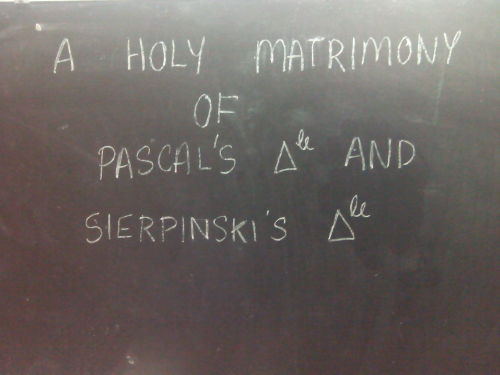
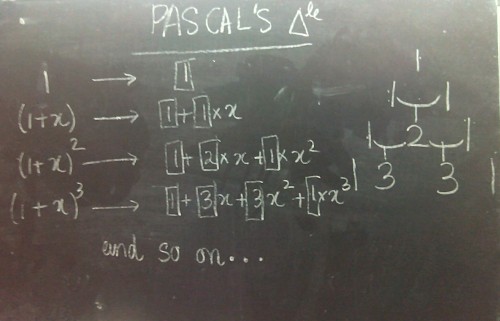
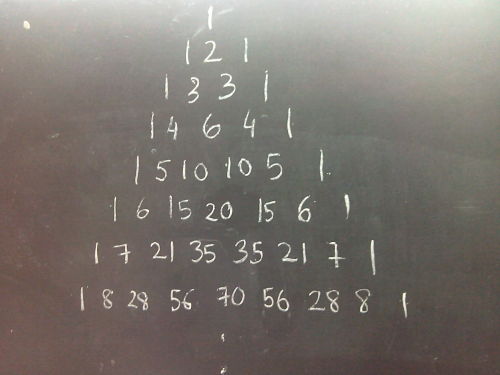
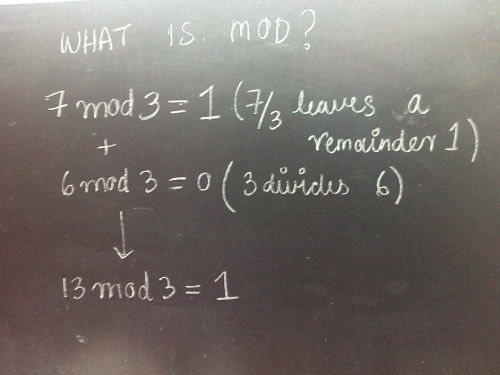
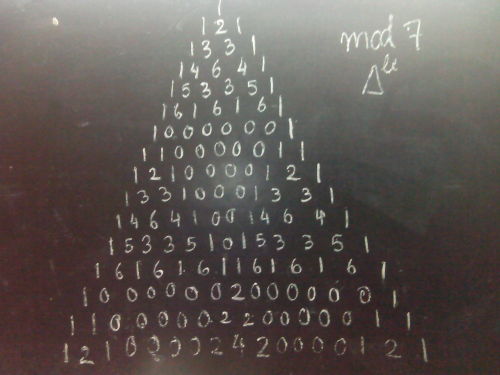
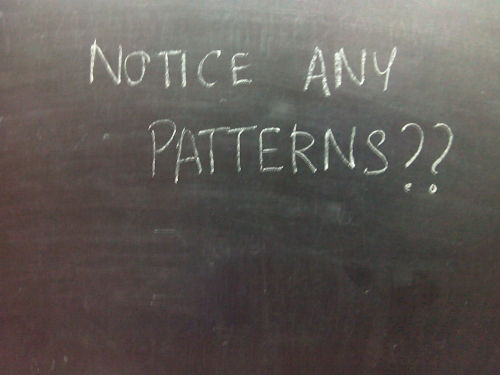
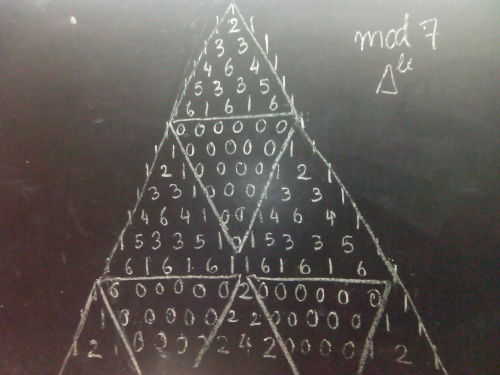
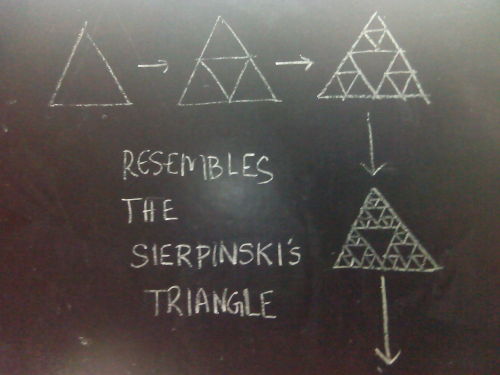
Nature manifests itself in patterns. The interweaving of math with these patterns produces euphoria
What do you see ? Let use know in the comments :)
Quench your thirst for knowledge with:
More about Pascals triangle and Binary Trees - Vihart
Scary Sierpinski Skull Time
Mathematical secrets of the pascal’s triangle
Code to generate Pascal’s triangle mod in Python


The fifth conic section - Straight line
Although many textbooks regard the straight line to be a specific case of the hyperbola and proclaim only four conic sections, it is something worth noting that the straight line is also a conic section.









PERIODIC SPONGE SURFACES AND UNIFORM SPONGE POLYHEDRA IN NATURE AND IN THE REALM OF THE THEORETICALLY IMAGINABLE
By Michael Burt- Prof emeritus, Technion, I.I.T. Haifa Israel
The diversity of shapes and forms which meets the eye is overwhelming. They shape our environment: physical, mental, intellectual. Theirs is a dynamic milieu; time induced transformation, flowing with the change of light, with the relative movement to the eye, with physical and biological transformation and the evolutionary development of the perceiving mind. “Our study of natural form “the essence of morphology”, is part of that wider science of form which deals with the forms assumed by nature under all aspects and conditions, and in a still wider sense, with forms which are theoretically imaginable ..(On Growth and Form D'Arcy Thompson), “Theoretically” to imply that we are dealing with causal- rational forms. “It is the business of logic to invent purely artificial structures of elements and relations. Sometimes one of these structures is close enough to a real situation to be allowed to represent it. And then, because the logic is so tightly drawn, we gain insight into the reality which was previously withheld from us” (C. Alexander). A particular interest should be focused on those structures which are shaped like solids or containers, with continuous two-manifold enveloping surfaces, enclosing a volume of space and thus subdividing the entire space into two complementary sub-spaces, sometimes referred to as interior and exterior, although telling which is which, is a relativistic notion. On each of these envelopes, topologically speaking, an infinite number of different maps composed of polygonal regions (faces), which are bounded by sets of edge segments and vertices, could be drawn, to represent what we call polyhedra, or polyhedral envelopes. We come to know them by various names and notations, evolving through many historical cultures up to our present times; each representing an individual figure-polyhedron, or a family, a group, a class or a domain; convex-finite, Platonic and Archimedean polyhedra; pyramids, prisms; anti-prisms; star polyhedra; deltahedra; zonohedra; saddle polyhedra, dihedral, polydigonal, toroidal, sponge like, finite and infinite polyhedra; regular, uniform, quasi-regular, and so forth; all inscribable in our 3-dimensional space. It is these structures and their extended derivatives which shape our physical-natural or artificial man-conceived environment and provide for our mental pictures of its architecture. The number of forms which had acquired a name or a specific notation through the ages is amounting to infinity, although the number of those which comprise our day to day formal vocabulary and design imagery is extremely (and regretfully) limited by comparison, even amongst designers and architects, whose profession, by definition, compels them to manipulate and articulate forms and space. Here it is right to observe that name-giving is part of the creative and generative process. The number of polyhedral forms which did not receive, as yet a proper name or a notation is also infinite. Infinite is also the number of potentially existing and possible imaginary periodic forms, not envisaged yet. Conspicuous are those relating to sponge-like labyrinthian, polyhedral, space dividing surfaces, which until quite recently were not even considered as a research topic. The interest in these forms has been prompted by our growing awareness of their abundance in nature and their importance, not only in describing micro and macro-physical and biological phenomena, but also in coping with morphological complexity and nature of our built environment and its emerging new architecture and the order and formal character of our living spaces, on either the building or the urban scale. Nature is saturated with sponge structures on every possible scale of physical-biological reality. The term was first adopted in biology: “Sponge: any member of the phylum Porifera, sessile aquatic animals, with single cavity in the body, with numerous pores. The fibrous skeleton of such an animal, remarkable for its power of sucking up water”. (Wordsworth dictionary). the entire study here
© Michael Burt- Prof emeritus, Technion, I.I.T. Haifa Israel

Smooth Ride, Bumpy Road
Why are wheels circular? Why aren’t they triangular or square shaped?
That is a question that you might have pondered at some point in your life ( perhaps as a shower-thought? ) But sometimes even the most simple questions have the most elegant answers!
A square wheel can roll smoothly if the ground consists of evenly shaped inverted catenaries of the right size and curvature.

What is a Catenary?
Well, it is the curve that a hanging cable assumes under its own weight when supported only at its ends. You find these everywhere!
Those chains on the pavement,

those hanging cables on a power transmission station,

or maybe a chandelier is of your type

All are catenaries!
Although it superficially resembles a parabola, it is NOT!
Practicality
The mythbusters (like always) decided to give the four wheel vehicle a try.
And found out that, get this - with speed, a truck fitted with square wheels can deliver a relatively smooth ride, despite that bouncy start!

Well, although circular wheels still remain as the king of wheels, it is nice to know that we do have some alternatives up our sleeve!
Merry Christmas :)
PC: Etan J. Tal, kamel15

Crows and ravens are pretty well known for their incredible smarts. In this experiment, psychologists sought to determine how well New Caledonian crows can infer weight.

You might be an engineer if you know how long a zeptosecond is. (It's a trillionth of a billionth of a second!) http://ow.ly/uUUb30caXrH
-
 lurker-at-thresholds liked this · 1 year ago
lurker-at-thresholds liked this · 1 year ago -
 seeorseem liked this · 5 years ago
seeorseem liked this · 5 years ago -
 uuuuuhhhhhhhhhhhhhhhhhh liked this · 5 years ago
uuuuuhhhhhhhhhhhhhhhhhh liked this · 5 years ago -
 vsco-baby reblogged this · 5 years ago
vsco-baby reblogged this · 5 years ago -
 go-wind-stuff reblogged this · 5 years ago
go-wind-stuff reblogged this · 5 years ago -
 count-your-shadows liked this · 6 years ago
count-your-shadows liked this · 6 years ago -
 goodenoughtolive liked this · 6 years ago
goodenoughtolive liked this · 6 years ago -
 nadalaya reblogged this · 6 years ago
nadalaya reblogged this · 6 years ago -
 radphysicist liked this · 6 years ago
radphysicist liked this · 6 years ago -
 infiltrator5252-braceforimpact liked this · 6 years ago
infiltrator5252-braceforimpact liked this · 6 years ago -
 urmomsgamingmouse-blog liked this · 7 years ago
urmomsgamingmouse-blog liked this · 7 years ago -
 ksnegi95 liked this · 7 years ago
ksnegi95 liked this · 7 years ago -
 lakeeffectsnow reblogged this · 7 years ago
lakeeffectsnow reblogged this · 7 years ago -
 petrifiedelectrify-blog liked this · 7 years ago
petrifiedelectrify-blog liked this · 7 years ago -
 fleurdebach5-blog liked this · 7 years ago
fleurdebach5-blog liked this · 7 years ago -
 dead-stream liked this · 7 years ago
dead-stream liked this · 7 years ago -
 vballjulia liked this · 7 years ago
vballjulia liked this · 7 years ago -
 justanothercarbonbasedlifeform reblogged this · 7 years ago
justanothercarbonbasedlifeform reblogged this · 7 years ago -
 justanothercarbonbasedlifeform liked this · 7 years ago
justanothercarbonbasedlifeform liked this · 7 years ago -
 livingintherainofhell liked this · 7 years ago
livingintherainofhell liked this · 7 years ago -
 radpaperwolf-blog liked this · 7 years ago
radpaperwolf-blog liked this · 7 years ago -
 t-sci-eng reblogged this · 7 years ago
t-sci-eng reblogged this · 7 years ago -
 mathart liked this · 8 years ago
mathart liked this · 8 years ago -
 i-elizaveth liked this · 8 years ago
i-elizaveth liked this · 8 years ago -
 tris09 liked this · 8 years ago
tris09 liked this · 8 years ago -
 swordlesbn reblogged this · 8 years ago
swordlesbn reblogged this · 8 years ago -
 theweezbeez reblogged this · 8 years ago
theweezbeez reblogged this · 8 years ago -
 theweezbeez liked this · 8 years ago
theweezbeez liked this · 8 years ago -
 isntthisneat liked this · 8 years ago
isntthisneat liked this · 8 years ago -
 gristobal liked this · 8 years ago
gristobal liked this · 8 years ago -
 quarkyteddybear liked this · 8 years ago
quarkyteddybear liked this · 8 years ago -
 ihavetoendit reblogged this · 8 years ago
ihavetoendit reblogged this · 8 years ago -
 kseniaafanasyevas reblogged this · 8 years ago
kseniaafanasyevas reblogged this · 8 years ago -
 kseniaafanasyevas reblogged this · 8 years ago
kseniaafanasyevas reblogged this · 8 years ago -
 jmarori2 liked this · 8 years ago
jmarori2 liked this · 8 years ago -
 unlovedlamppost liked this · 8 years ago
unlovedlamppost liked this · 8 years ago -
 1wolfarchive liked this · 8 years ago
1wolfarchive liked this · 8 years ago